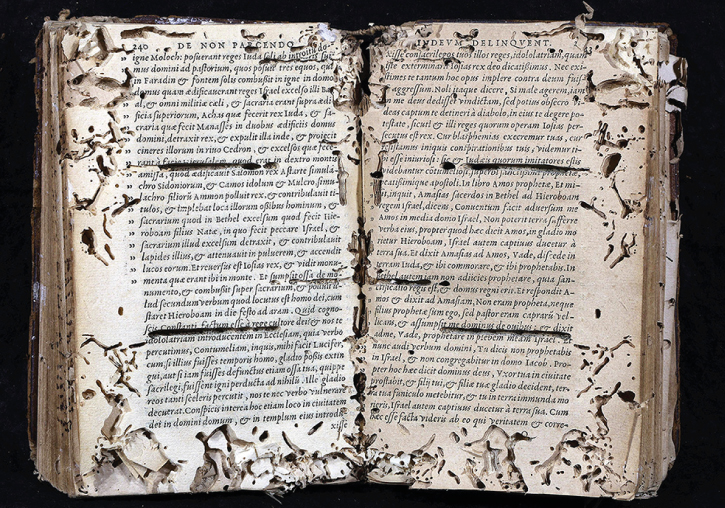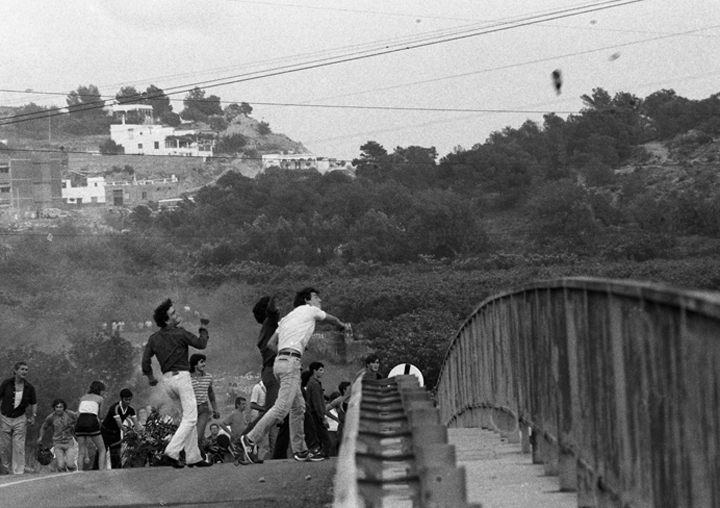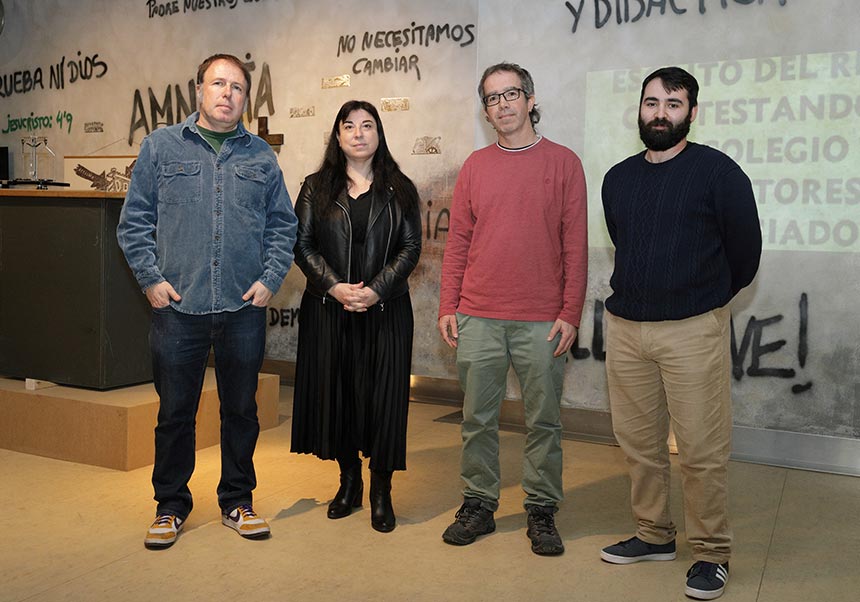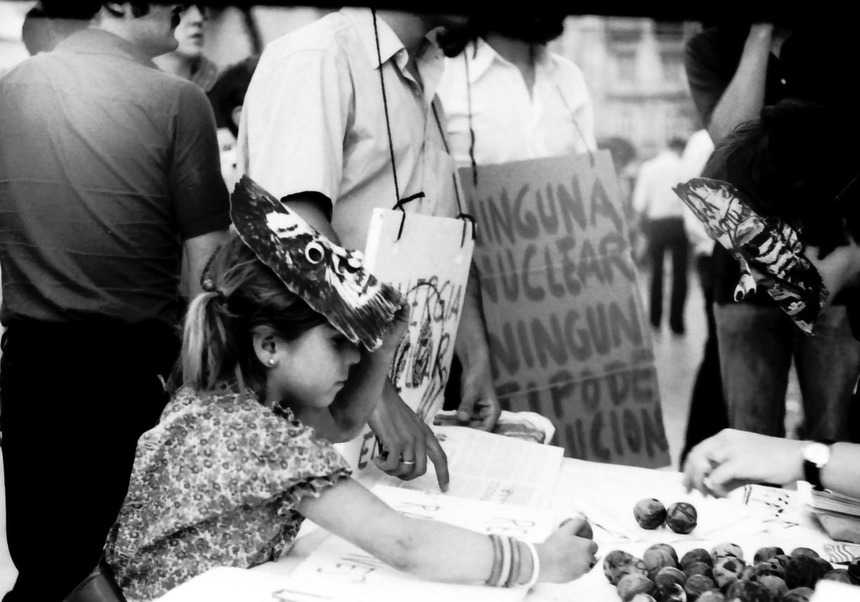The Historical Library shows the wounds and scars of its books in the ‘Malheridos. La huella del tiempo en las bibliotecas REBIUN’ exhibition
- Biblioteca Històrica
- May 19th, 2022

The Universitat de València presents the ‘Malheridos. La huella del tiempo en las bibliotecas REBUIN’ exhibition (‘Badly hurt. The footprint of time in the REBUIN libraries’. This project is organised by the office of the Vice-Principal for Research and the Historical Library, who invite us to dive into the universe of books and to get to know all the different factors that threaten their preservation and continued existence. The tour along this quite unknown bibliographic and documentary heritage allows to observe documents that are not normally included in exhibitions due to the damage they present.
Between the 19th of May and the 4th of September, the Duque de Calabria room of the Cultural Centre La Nau will host a selection of safeguarded documents in the Historical Library that show the ‘badly hurt’ condition of the works.
The exhibition has been presented in the opening, which was celebrated on Thursday at the Duque de Calabria room of the Historical Library. Among the participants were Carlos Hermenegildo Caudevilla, Vice-Principal for Research; María Jesús García Mateu, director of the Historical Library; and Susana González Martínez and Mónica Pintado Antúnez, curators of the exhibition who are also restorers at the Libraries and Documentation Service of the Universitat de València.
The exhibition will take place on the 26th and 27th of May at the Botanical Garden in the framework of the III Conference on Bibliographic Heritage Management. It was organised by the REBUIN (Red de Bibliotecas Universitarias Españolas) bibliographic heritage work group as well as the Universitat de València.
Through a selection of more than fifty documents among which there are seven manuscripts and five incunabula, the main causes for the alteration of their integrity will be unveiled. These causes include the action of merciless censorship; devastation caused by catastrophes; the effects of the degradation of materials (paper, inks, bindery); the effects of biological agents capable of producing destruction; or the human factor, which is the one that most affects the bibliographic and documentary heritage, either consciously or simply due to ignorance or negligence.
The exhibition is divided into six sections: ‘Censorship’, ‘Disasters’, ‘Intrinsic causes of deterioration’, ‘bio deterioration’, ‘Human factor’, ‘Restoration’ and ‘Preventive conservation’. The five first sections showcase the different causes of deterioration of bibliographic documentary collections of the Universitat de València, while the last one deals with general aspects related with basic guidelines to consider in the preservation and custody of documentary and bibliographic heritage. In these sections, works from between the 14th and 20th century will be shown, such as manuscripts, incunabula and rare and interesting books that show their wounds.
The first section, ‘Censorship’, is an evidence of the actions of the Inquisition or those of ancient book owners. Among the works form the exhibition, there are many works that stand out, such as the ‘Cançoner de Maians’ manuscript. This work transcribes the works of Joan Roís de Corella, who suffered a process of auto censorship by which he cancelled the text where he started his work ‘La suplicació de natura humana’ with a big stain of ink that prevented its reading. Another work that stands out is the incunabulum of Dante Alighieri’s Divine Comedy, printed in 1491, which was a victim of the inquisitorial action that hid sections of the book by sticking pieces of paper on it that visibly damaged the document.
The second section, ‘Disasters’ is focused on the big flood of Valencia in 1957. Its effects can be noticed in a copy of a work by Luis Vives, ‘Tratado del socorro de los pobres’, printed in Valencia in 1781, on which a layer of mud from the disaster can still be noticed. Some documents preserved in the Historical Archive of the Universitat de València will also be exhibited, such as photographs and reports from restorer Benito Angulo Luengo and architect Javier Goerlinch, who are direct witnesses of the damage produced in the library and the building of the university due to the catastrophe.
The section ‘Intrinsic causes’ offers a vision of how the different quality of materials and the way paper and inks were produced has influenced the conservation of the books. A volume of the Encyclopédie de Diderot and d’Alembert with a print about the airing of the sheets during their manufacturing will also be exhibited.
The fourth section, ‘Bio deterioration’ centres on the biological agents and the severe problems that they entail for the collection of archives and libraries, which were home to insects and rodents during many years. Their effects remain reflected on a selection of books that present holes, tunnels and severe material losses.
The fifth section, ‘Human factor’ includes books that were mutilated by human greed and damaged by old restoration interventions that, over the course of time, have ended up being unfortunate. In this section, a true bibliographic gem from the 14th century, ‘Roman de la Rose’, is exhibited. It is a copy of the codex collection of the Duke of Calabria, two of which were mutilated in the 14th century.
The exhibition ends with the section ‘Restoration and Preventive conservation’, where the current restoration work that allows to retrieve damaged copies is highlighted. Such is the case of the ‘Diari del compromís de Casp’, from 1412, which was subject to a process of dry restoration. Likewise, the importance of daily work when controlling the preservation condition is also highlighted, such as key aspects to preserve heritage collections.
‘Malheridos’ offers the opportunity to contemplate a different vision of common bibliographic exhibitions. It offers a curated selection of works from the university bibliographic heritage that were marked by the scars of history. The Historical Library is responsible for their custody and care, ensuring their preservation so that their knowledge and inestimable historical value get to future generations as a legacy of our identity and culture. The caring of the books is an act of responsibility and solidarity and an exercise of enrichment of culture and respect towards society.
File in: Cultura , Exposicions , Centre Cultural La Nau
















